Exam Details
Exam Code
:JN0-692Exam Name
:Service Provider Routing and Switching Support, ProfessionalCertification
:JNCIAVendor
:JuniperTotal Questions
:171 Q&AsLast Updated
:Apr 09, 2025
Juniper JNCIA JN0-692 Questions & Answers
-
Question 51:
Click the Exhibit button.
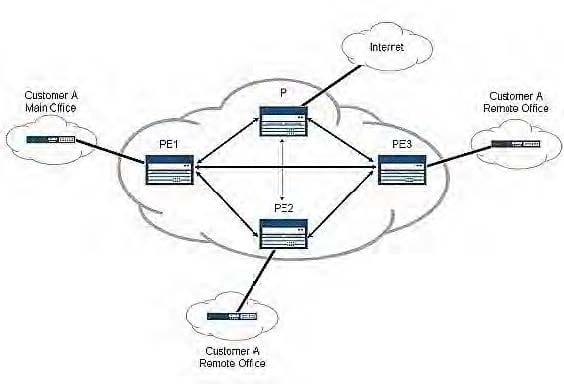
In the exhibit, Customer A uses private RFC1918 addresses within its network. The customer wants to have all Internet access for its organization transit through the main office for security and NAT purposes. Each of the PE routers in your network contains Internet routes in the main instance routing table and is capable of provisioning both a VRF and a non-VRF interface to its attached CE router. Which router should be configured to accomplish the administrative goal of the customer?
A. P
B. PE1
C. PE2
D. PE3
-
Question 52:
Click the Exhibit button.
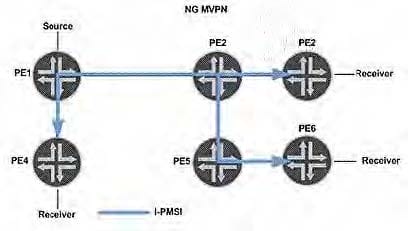
In the exhibit, NG-MVPN is used for a Layer 3 VPN. Which two statements are valid? (Choose two.)
A. The egress PEs for I-PMSI tunnels should signal a label value of 3.
B. The vrf-table-label parameter is configured on the PEs.
C. PIM must be enabled on the PE and P routers.
D. The provider tunnel shown is similar to a draft-Rosen default MDT.
-
Question 53:
Click the Exhibit button.
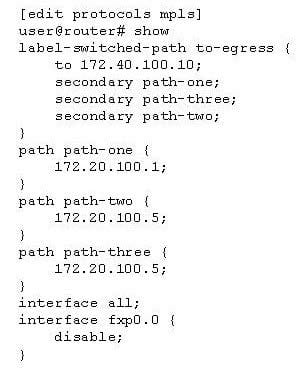
Based on the configuration in the exhibit, which statement is correct?
A. If path-one fails, the LSP will attempt to signal a new LSP using path-three.
B. If path-one fails, the LSP will attempt to signal a new LSP using path-two.
C. If path-one fails, the LSP will not attempt to signal a new LSP.
D. If path-one fails, the LSP will attempt to signal a new LSP using both path-two and path- three.
-
Question 54:
Click the Exhibit button.
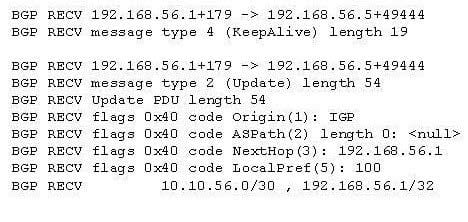
The exhibit contains a sample trace file of a BGP update message. Which two statements are true? (Choose two.)
A. 10.10.56.0/30 is a route internal to the AS.
B. The router that sent this update is the BGP originator of 10.10.56.0/30.
C. The BGP session is EBGP.
D. The local preference has been changed from the default settings.
-
Question 55:
Click the Exhibit button.
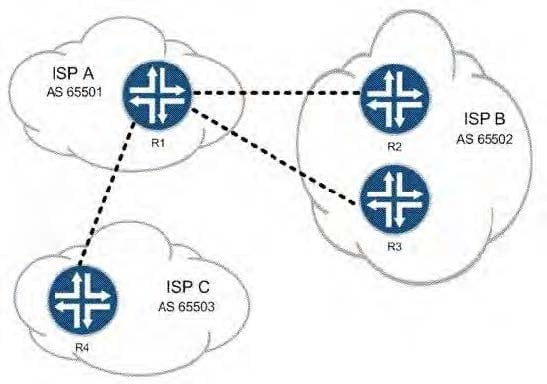
Your employer is ISP A. Your customers must be able to reach customers of both ISP B and ISP C, but your network must not allow transit traffic between ISP B and ISP C at any time. Referring to the exhibit, what are two solutions? (Choose two.)
A. Use policy to filter routes on AS number.
B. Use the well-known no-export community.
C. Use the MED to prefer the proper routes.
D. Use communities to identify and filter routes.
-
Question 56:
Click the Exhibit button.
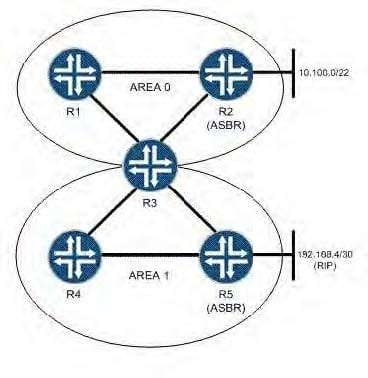
You are asked to configure an OSPF network based on the topology shown in the exhibit. Area 1 must not receive Type 5 LSAs from the backbone, but must be capable of containing ASBRs. What will accomplish this?
A. Area 1 should be configured as a stub area, which by default meets the network's requirements.
B. R3 should be configured with no-externals for Area 1, which will suppress Type 5 announcements.
C. R3 should be configured with no-summaries for Area 1, which will suppress Type 5 announcements.
D. Area 1 should be configured as an NSSA, which by default meets the network's requirements.
-
Question 57:
Click the Exhibit button.
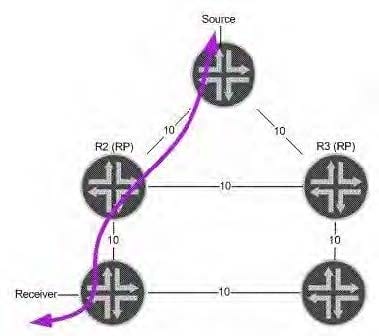
In the exhibit, R2 and R3 are both rendezvous points. Assume that R2 fails. Which RP redundancy method could converge the multicast stream and RP as quickly as the IGP?
A. BSR without the use of MSDP
B. Anycast RP and MSDP
C. Auto-RP in combination with MSDP
D. Auto-RP without using MSDP
-
Question 58:
Which two statements are true when configuring OSPF authentication? (Choose two.)
A. An OSPF link can support both simple password and MD5 authentication at the same time.
B. An MD5 password requires a key ID.
C. You can configure multiple MD5 passwords simultaneously on the same link.
D. If the MD5 password negotiation fails, you can configure OSPF to automatically use a simple password as a backup.
-
Question 59:
Which three statements are true about the BGP community attribute? (Choose three.)
A. There are three well-known communities.
B. Communities can be used to signal local preference in other AS networks.
C. Only well-known communities can be passed between AS networks.
D. Routing policies can be simplified using BGP communities.
E. Communities are used in the route selection process.
-
Question 60:
An IS-IS level 1-only router is configured within a larger multilevel hierarchy. Which OSPF area type resembles the routing information in the L1 router's table?
A. OSPF default area
B. OSPF stub area
C. OSPF NSSA
D. OSPF NSSA with no summaries
Related Exams:
Tips on How to Prepare for the Exams
Nowadays, the certification exams become more and more important and required by more and more enterprises when applying for a job. But how to prepare for the exam effectively? How to prepare for the exam in a short time with less efforts? How to get a ideal result and how to find the most reliable resources? Here on Vcedump.com, you will find all the answers. Vcedump.com provide not only Juniper exam questions, answers and explanations but also complete assistance on your exam preparation and certification application. If you are confused on your JN0-692 exam preparations and Juniper certification application, do not hesitate to visit our Vcedump.com to find your solutions here.